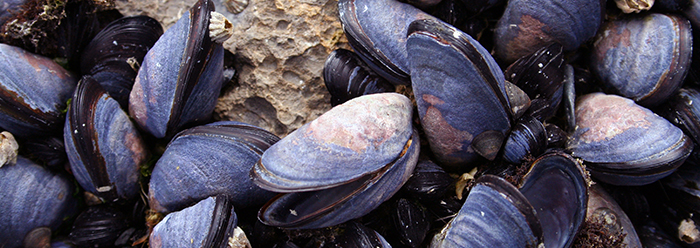Asphalt volcanos really do exist on the ocean floor. They leak natural gas, oil, and the same type of black glop we use for road pavement. They have been oozing for who knows how long, although scientists discovered them only 15 or so years ago. Unique sea creatures team up to eat their petroleum products. How could any living thing live off natural gas?
We know of special bacteria that eat oil. For example, they cleaned up the Gulf of Mexico after the Deepwater Horizon oil spill more quickly than some thought possible.1 But the mussels, sea worms, crabs, sponges, and other animals that thrive on the slopes of asphalt volcanos cannot eat oil.
Researchers discovered how they live. Turns out, gas-eating bacteria live inside the gill cells of seafloor mussels. The bacteria also live inside sponge tissues.2
Mussels use their gills not only for vital gas exchange, but also to absorb nutrients from seawater. In this case, they also supply little homes in which bacteria live—but the mussels charge rent. The bacteria convert nearby oil-associated gases like butane, ethane, and propane into carbon compounds useful for life. The bacteria extract enough energy and carbon to meet their own needs, plus those of their mussel landlords.
This symbiotic partnership inspires a good creation question: How did such completely different life forms ever begin working so closely together in the first place? It may sound too simplistic to say that God created them to work together, but when considering how unlikely these creatures could ever have figured it out on their own, the God explanation floats to the top.
If this setup evolved naturally instead of God making it, then long ago some bacteria must have tried to penetrate a mussel gill cell. The mussel would have defended itself against such an invasion. What would motivate gill cells to allow bacteria to enter? They don’t see big pictures or potential symbiotic relationships. How would they know to make an exception to infection for bacteria that might supply vital nutrients from unlikely compounds like propane? Clearly, God saw the big picture. He has the skill and wisdom to craft this sea floor odd couple into a flourishing partnership.
And as a bonus, the symbiotic mussels and sponges constantly clean propane and its chemical cousins from ocean water. Meanwhile, free-living bacteria mop up thicker petroleum products such as oil. This prompts a second creation question: How can these edible petroleum products keep surfacing after millions of years?
Oil comes from buried life forms (mostly algae) and still rises from the ground. If those life forms were buried millions of years ago, shouldn’t all the oil and natural gas from their baked bodies have risen up for bacteria to eat long ago? Shouldn’t these symbiotic mussels be extinct by now, having lost their nutritious oil supply?
The recent Genesis Flood better explains the existence of oil and its vast reserves around the world.3 The Flood only needed to bury about a tenth of the amount of algae found in today’s oceans to supply all of today’s known oil reservoirs.4 Since it happened only thousands of years ago, no wonder oil continues to rise today. Genesis creation explains the symbiotic design behind mussels and propane-digesting bacteria, and the Genesis Flood explains why those mussels and bacteria still have plenty to eat.
References
- Thomas, B. Oil-eating Bacteria Are Cleaning Up Gulf. Creation Science Update. Posted on ICR.org August 27, 2010, accessed June 22, 2017.
- Oil as energy source for deep-sea creatures. Max Planck Gesellschaft Research News. Posted on mpg.de June 20, 2017, accessed June 20, 2017.
- Clarey, T. 2013. Oil, Fracking, and a Recent Global Flood. Acts & Facts. 42 (10): 14-15.
- Woodmorappe, J. 1986. The Antediluvian Biosphere and Its Capability of Supplying the Entire Fossil Record. In Proceedings of the First International Conference on Creationism, vol. II. R. E. Walsh, et al., eds. Pittsburgh, PA: Creation Science Fellowship, Inc., 205-213; Technical Symposium Sessions and Additional Topics.
*Mr. Thomas is Science Writer at the Institute for Creation Research and earned his M.S. in biotechnology from Stephen F. Austin State University.
Article posted on July 6, 2017.














